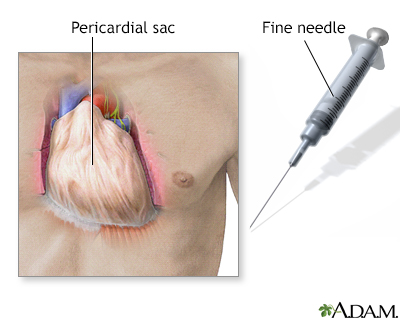Pregnancy SmartSiteTM
Dressler syndrome; Post-MI pericarditis; Post-cardiac injury syndrome; Postcardiotomy pericarditis DefinitionPericarditis is inflammation and swelling of the covering of the heart (pericardium). It can occur in the days or weeks following a heart attack.  CausesTwo types of pericarditis can occur after a heart attack. Early pericarditis: This form most often occurs within 1 to 3 days after a heart attack. Inflammation and swelling develop as the body tries to clean up the damaged heart tissue.  Late pericarditis: This is also called Dressler syndrome. It is also called post-cardiac injury syndrome or postcardiotomy pericarditis). It most often develops several weeks or months after a heart attack, heart surgery, or other trauma to the heart. It can also happen a week after a heart injury. Dressler syndrome is thought to occur when the immune system attacks healthy heart tissue by mistake. Things that put you at higher risk for pericarditis include:
SymptomsSymptoms include:
Exams and TestsThe health care provider will listen to your heart and lungs with a stethoscope. There may be a rubbing sound (called a pericardial friction rub, not to be confused with a heart murmur). Heart sounds in general may be weak or sound far away. A buildup of fluid in the covering of the heart or space around the lungs (pericardial effusion) is not common after a heart attack. But, it often does occur in some people with Dressler syndrome. Tests may include:
TreatmentThe goal of treatment is to make the heart work better and reduce pain and other symptoms. Aspirin may be used to treat inflammation of the pericardium. A drug called colchicine is often used as well. In some cases, excess fluid surrounding the heart (pericardial effusion) may need to be removed. This is done with a procedure called pericardiocentesis. If complications develop, part of the pericardium may sometimes need to be removed with surgery (pericardiectomy).  Outlook (Prognosis)The condition may recur in some cases. Possible ComplicationsPossible complications of pericarditis are: When to Contact a Medical ProfessionalContact your provider if:
ReferencesJouriles NJ. Pericardial and myocardial disease. In: Libby P, Bonow RO, Mann DL, Tomaselli, GF, Bhatt DL, Solomon SD, eds. Braunwald's Heart Disease: A Textbook of Cardiovascular Medicine. 12th ed. Philadelphia, PA: Elsevier; 2022:chap 68. Lewinter MM, Cremer PC, Klein AL. Pericardial diseases. In: Libby P, Bonow RO, Mann DL, Tomaselli, GF, Bhatt DL, Solomon SD, eds. Braunwald's Heart Disease: A Textbook of Cardiovascular Medicine. 12th ed. Philadelphia, PA: Elsevier; 2022:chap 86. Maisch B, Ristic AD. Pericardial diseases. In: Vincent J-L, Abraham E, Moore FA, Kochanek PM, Fink MP, eds. Textbook of Critical Care. 7th ed. Philadelphia, PA: Elsevier; 2017:chap 84. | |
| |
Review Date: 10/5/2022 Reviewed By: Thomas S. Metkus, MD, Assistant Professor of Medicine and Surgery, Johns Hopkins University School of Medicine, Baltimore, MD. Also reviewed by David C. Dugdale, MD, Medical Director, Brenda Conaway, Editorial Director, and the A.D.A.M. Editorial team. The information provided herein should not be used during any medical emergency or for the diagnosis or treatment of any medical condition. A licensed medical professional should be consulted for diagnosis and treatment of any and all medical conditions. Links to other sites are provided for information only -- they do not constitute endorsements of those other sites. No warranty of any kind, either expressed or implied, is made as to the accuracy, reliability, timeliness, or correctness of any translations made by a third-party service of the information provided herein into any other language. © 1997- A.D.A.M., a business unit of Ebix, Inc. Any duplication or distribution of the information contained herein is strictly prohibited. | |

 Acute MI
Acute MI Pericardium
Pericardium Pericarditis post-...
Pericarditis post-... Pericardium
Pericardium
